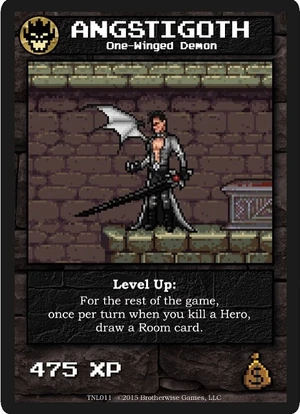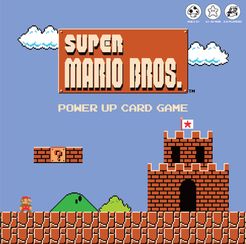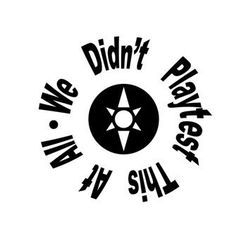
GAME DESCRIPTION: Adrenaline is a board game for 3-5 players for Cranio Creations. Players take the role of 1 of 5 characters and attack the other characters with various forms of weaponry and rack up kills.
BOARD SET-UP: Each player takes the 2 board pieces and lay them out on any side combination. Place 5 to 8 red plastic skulls on the Kill Fshot track located at the top of the board, depending on the length of the game. Shuffle the small Power-up (indicated by a lightning bolt on the back) and large Weapon (indicated by a gun) decks. Draw 9 Weapons into each matching gun space on the board. Shuffle the Ammo tiles and place 1 onto each space marked with a circle inside a square.
PLAYER SET-UP: Each player takes a double sided colored board and matching Action Tile, with the side with the 8 and the Action Tile with only a "x2" face-up. Each player also takes their character and matching blood shaped Wound tokens, and 3 of each different colored Ammo cubes into their personal supply, placing 1 of those 3 onto their portrait, or Ammo Box. Finally, give the first player the Starting Player marker.

SPAWNING: Players begin their first turn by drawing 2 Power-up cards, and discarding one. The colored cube at the bottom of the discarded one indicates in which color the player is spawning. Players spawn in the spaces with a large circle and smaller square next to it, where no Ammo tiles should be placed.
ACTION: Once a player has Spawned, or during a normal turn, they may take up to 2 of the following actions, in any order, or even taking the same action twice. At the end of the turn:
- Movement: Move up to three spaces. A player cannot move through walls or diagonally.
- Grab stuff: A player may move up to one space and grab something. Players cannot grab and then move with this action.
- Shoot: A player must have a loaded Weapon, indicate by being in the hand.
- Reload: This action only takes place at the end of the turn, before reserving any kills.
ITEMS: If an Ammo token is "grabbed", the grabbing player moves up to that many from their personal supply to their Ammo Box. If there is less Ammo then indicated in the supply, the player moves all that colored Ammo into their box. If a Power-Up card is shown, that player draws 1 Power-up card, and puts in their hand to a max of 3 cards. At the end of the turn, replace any Ammo tokens that were taken. If there are no more tokens, shuffle the discarded ones.
WEAPONS: If a grab action is used in a Spawn room, then the player may take 1 of the Weapons next to that spawn room by paying its cost, ignoring the top colored cube, and then move any other required cubes from the Ammo Box back to the personal supply. Add the paid for weapon to your hand. If a player has more than 3 Weapons, they must discard 1 into the slot from where it was just purchased. At the end of the turn, replace any Weapon cards that were taken from the deck. If the Weapon deck runs out, do not replace it.

SHOOTING: If a player is using a Weapon to attack, it is placed in front of them, following the rules on the card and in the Weapons manual. If the Weapon has any special abilities or alternate moves, the player may choose to use the ability by paying the Ammo Cubes indicated next to that ability from their Ammo Box. Then the Weapon is placed face-up in front of the player, and must be re-loaded using the whole cost indicated at the top from their Ammo box at the end of the turn. Any re-loaded gun is added to the players hand.
POWER-UPS: A player may discard a Power-up to add its colored cube at the bottom to any cost required. Power-ups also have special effects to add more damage, Mark a player, or move a player's figure.
DAMAGE: When a player is dealt damage, that player is given Wound tokens from the attacking player equal to the damage given. It is added to the damage track from left to right. Once a player has taken 3 Wounds, that player may now move up to 2 spaces and pick up an item as part of their actions, as shown on the board. If a player has taken 6 Wounds, they may now move 1 and attack as part of their action, again according to the Wound token. If a player takes 11 Wounds, they take a Kill shot. Once a player has taken a 12th Wound, they take Overkill, and any other Wounds or Marks are ignored.
MARKS: Marks are indicated on certain weapons with a double red circle. For each Mark, add a Wound token to the top of that players board, for a max of 3 from each player at any one time. The next time that player does damage, add the Mark to the damage track.
DEATH: Once a player has taken a Kill shot, they are dead. If a player gets 2 or more Kill shots, they score 1 more point. Tip the figure over, and the "dead" player may still be able to take Overkill. At the end of turn, after Reloading, the players score on any players board who received a Kill shot or Overkill. The first player who shot gains 1 point. The player who put the most total damage gains 8 points, as shown on the bottom of the damage tracks. The 2nd most gains 6, etc. Any tie is broken by giving the highest points to the player closest to the left. The other tied player(s) get the number next indicated. Any players not on the Damage Track or have only Marks do not score any points.

SKULLS: Once a dead player has been scored on, return all Marks and Wounds on the player, and the killed player takes the Wound token from the Killshot space, and puts it in place of the left most Skull on the Killshot track. Any Overkill is placed on top, and the dead player Marks the player who caused the Overkill. Take the skull and place it on top of the highest point of the dead player. Players cannot gain points from any indicator covered by the skull. The dead player will now only generate 6 points and lower for their highest score on their next death. The dead player draws a new power-up card, discards a card and respawns there. Any previous Weapons or Power-ups stay with the player in the position they were previously.
WINNING: Players are given Point tokens to represent their points, which are placed face-down on the side of the board. Score the Killshot track from using the points to the left of the track as you would a dead player. Once all Point tokens are given and counted, the player with the most points wins.

SHOOTING: If a player is using a Weapon to attack, it is placed in front of them, following the rules on the card and in the Weapons manual. If the Weapon has any special abilities or alternate moves, the player may choose to use the ability by paying the Ammo Cubes indicated next to that ability from their Ammo Box. Then the Weapon is placed face-up in front of the player, and must be re-loaded using the whole cost indicated at the top from their Ammo box at the end of the turn. Any re-loaded gun is added to the players hand.
POWER-UPS: A player may discard a Power-up to add its colored cube at the bottom to any cost required. Power-ups also have special effects to add more damage, Mark a player, or move a player's figure.
DAMAGE: When a player is dealt damage, that player is given Wound tokens from the attacking player equal to the damage given. It is added to the damage track from left to right. Once a player has taken 3 Wounds, that player may now move up to 2 spaces and pick up an item as part of their actions, as shown on the board. If a player has taken 6 Wounds, they may now move 1 and attack as part of their action, again according to the Wound token. If a player takes 11 Wounds, they take a Kill shot. Once a player has taken a 12th Wound, they take Overkill, and any other Wounds or Marks are ignored.
MARKS: Marks are indicated on certain weapons with a double red circle. For each Mark, add a Wound token to the top of that players board, for a max of 3 from each player at any one time. The next time that player does damage, add the Mark to the damage track.
DEATH: Once a player has taken a Kill shot, they are dead. If a player gets 2 or more Kill shots, they score 1 more point. Tip the figure over, and the "dead" player may still be able to take Overkill. At the end of turn, after Reloading, the players score on any players board who received a Kill shot or Overkill. The first player who shot gains 1 point. The player who put the most total damage gains 8 points, as shown on the bottom of the damage tracks. The 2nd most gains 6, etc. Any tie is broken by giving the highest points to the player closest to the left. The other tied player(s) get the number next indicated. Any players not on the Damage Track or have only Marks do not score any points.

SKULLS: Once a dead player has been scored on, return all Marks and Wounds on the player, and the killed player takes the Wound token from the Killshot space, and puts it in place of the left most Skull on the Killshot track. Any Overkill is placed on top, and the dead player Marks the player who caused the Overkill. Take the skull and place it on top of the highest point of the dead player. Players cannot gain points from any indicator covered by the skull. The dead player will now only generate 6 points and lower for their highest score on their next death. The dead player draws a new power-up card, discards a card and respawns there. Any previous Weapons or Power-ups stay with the player in the position they were previously.
WINNING: Players are given Point tokens to represent their points, which are placed face-down on the side of the board. Score the Killshot track from using the points to the left of the track as you would a dead player. Once all Point tokens are given and counted, the player with the most points wins.
CONCLUSION: Adrenaline seems like a rather complex and ambitious game, but that isn't exactly true. While scoring and setting-up seems complicated, it's not hard once you start seeing the patterns. There's also more modes with Domination, Final Frenzy, and Bot mode. Each adds more rules to the game that I haven't even touched yet. However, there is a lot of replay value to this game just with the amount and combination of Weapons it has to offer. Adrenaline very much feels like if Quake or a multiplayer Doom were made into a board game. There's plenty of hectic, wild energy that this game provides. Again, the amount of weapons is great, but most of the weapons feel different, from melee based scythes and chainsaws to chain lightning guns and shotguns. The abilities add something unique to guns that might feel the same, as do the power-ups. A solid game that could easily have come from the First Person Shooter video game genre.
Also, the rules have some real character. Go read them, even if you aren't planning on playing it.







